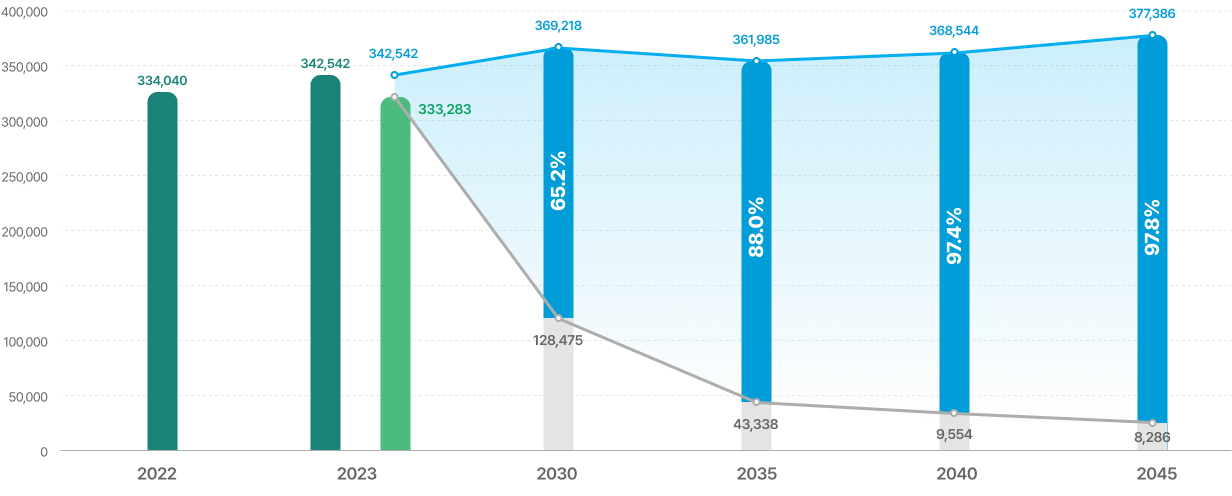ESG Strategy

ESG Strategy Framework
ESG Vision

Transformation to Sustainable Mobility
Strategic Direction
- Strengthening Ecofriendly Management
- Establishment of a Human Rights Management System
- Expansion of Stakeholder Communicatio
Key Tasks
- Establishment of a carbon-neutral systemCreating a sustainable environment for future generations through carbon-neutral implementation efforts across the entire value chain
- Establishment of a human rights risk management systemEstablishment of a human rights risk management system: Active implementation of human rights management, along with the prevention of human rights violations and mitigation of related risks in business operations
- Expansion of social contribution impactContributing to the sustainability of future generations by solving local community issues
- Expansion of eco-friendly product developmentFulfilling the role of a global corporate citizen through the expansion of eco-friendly product development for customers and nature
- Promotion of diversity and inclusionEnhancing efforts to create a society free of discrimination and spread a culture of diversity and inclusion within the organization
- Innovation in customer experience and enhancement of product reliabilityProviding valuable products and services to customers at the optimal moment when they are needed
- Establishment of eco-friendly workplacesReducing the discharge of pollutants from business sites to minimize the impact on local communities and the natural environment
- Internalizing safety and healthEstablishing high-quality, safe jobs through the proactive prevention of safety accidents, and the expansion and internalization of a safety culture
- Establishment of a sustainable supply chainEstablishment of a sustainable supply chain: Building a supply chain ESG management process to assess, manage, and improve potential ESG risks of suppliers
- Creation of future jobsSecuring growth drivers and expanding social contributions through the recruitment of talent in the eco-friendly sector, as well as providing employment opportunities
- Corporate culture innovationBuilding a creative and horizontal corporate culture through active participation and communication among members, strengthening capabilities, and fostering innovative and flexible talent
- Ensuring board integritySecuring independence, diversity, and expertise of the board of directors with the aim of improving its integrity and operational efficiency
Carbon Neutrality Strategy
Vision

Achieving Carbon Neutrality in 2045
Objectives
- Expanding green business through the increased proportion of ecofriendly products
- Achieving eco-friendly factories through energy transition
- Capacity building for sustainable product manufacturing
Strategy Themes
-
R
Responsible
Partnership -
O
Optimization with
Smart Operation -
A
Accelerating the
Energy Transition -
D
Design to
Sustainable Mobility
Initiatives
Establishing a carbon management system for suppliers.Transition to ecofriendly transportation methods
Reduction of energy consumption through operational efficiencyPromotion of green building by improving energy consumption
Transition to renewable energyIntroduction of carbon-free future energy technology
Transition to electrification businessSustainable product design
Carbon Neutrality Roadmap
- Unit : KRW (KW)
-
 Scope 1+2 Emissions
Scope 1+2 Emissions Scope 1+2 Target Emissions
Scope 1+2 Target Emissions Target Emissions(tCO2eq)
Target Emissions(tCO2eq) BAU Forecast Value(tCO2eq)
BAU Forecast Value(tCO2eq)

- 1.Carbon Emission Forecast (BAU) Calculation Criteria
- The carbon emission forecast for 2032 is based on the medium-to-long-term business plans for powertrains and seats (2024-2032) and the average unit values from the past four years (2020-2023).
- For the period after 2033, the carbon emission forecast up to 2045 is calculated based on the average growth rate of the business plans for 6 years (2027-2032).
- 2.Carbon Reduction Target Calculation Criteria
- The Scope 2 reduction target is calculated according to the RE100 achievement strategy for all domestic and international business sites.
- The Scope 1 reduction target is calculated based on the SBTi reduction pathway, focusing on investments in energy efficiency for production processes and the transition to electric vehicles.

